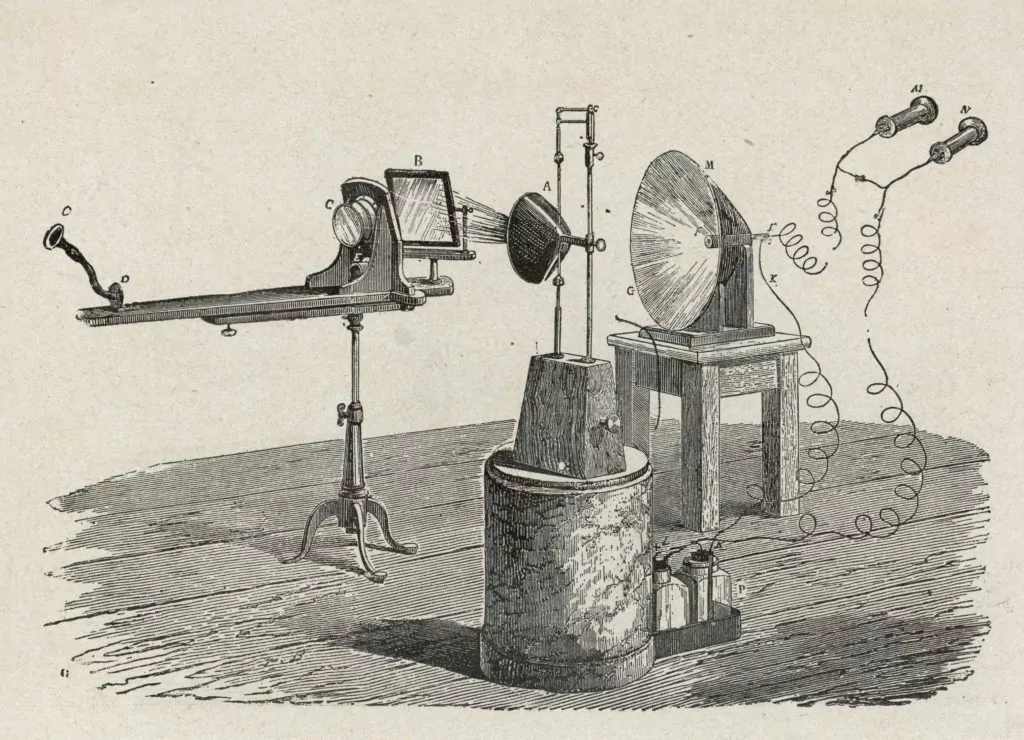This is the complete history of Zoom.
From clay sheets to Zoom—humans improved their communication methods quite a bit.
So if you want to learn the COMPLETE history of Zoom, then this article is for you.
Let’s get right into it!
- What is Right to Repair: Tech With Tech’s Role
- Complete History of YouTube
- Complete History of Information Technology

From Scrolls to Zoom—the Big Picture
For as long as humans have been trading goods, there have been business meetings.
Granted these early business meetings were small and incredibly local to place.
Yet, communication happened and business got transacted.
Then, when confronted with the issue of communicating information long distance and the time it took to get to the next destination, humans created writing.
From there, mathematics was invented to keep track of all the businesses being transacted.
Imagine the scene, I think you might agree that lugging around those bulky clay inventory sheets or scrolls got annoying after a while.

So, like all great problem solvers, humans continued to improve communication tools and the time it took to get a response from a relative or business partner hundreds of miles away.
Some may have even dreamed of a system like Zoom or GoToMeeting, but it would take thousands of years of scientific development to get there.
Communication Was Limited to How Fast You Could Travel
Basically, for most of human history distance communication could only travel as fast as a human could walk or sail or a horse, or some other pack animal could walk or run.
To give you an idea of the time involved, it could take as little as six weeks or almost three months to transport information from Europe to America in the eighteenth century.
It all depended upon the time of year, how strong the winds were, and which route you took—the high northern route or the southern swing down to the Canary Islands with a turn to the Caribbean and then up the eastern coast of North America.
Another way to think about it is: Today in a car, one can travel from Washington, DC to Philadelphia in about four hours when, during George Washington’s time, it could take up to four days.
People were obviously incredibly patient back then. They had to be.
However, many of George Washington’s contemporaries explored their world scientifically and built upon the ideas that earlier curious people developed.
By the time George Washington died in 1799, people had a pretty good handle on what electricity was and how it interacted with other materials.

They also were fascinated by weather and the atmosphere and those studies helped to gain a better understanding of thermodynamics, wave action, and electromagnetism which set everything up for a communication breakthrough that would start a chain reaction.
Electricity Was the Key
Throughout the first third of the nineteenth century, scientists explored how to harness electricity. They knew electrical impulses had power and could move through substances.
In fact, they had been aware of this phenomenon as early as 1672 when Robert Hooke conducted an experiment that helped to illustrate that principle—remember the cup and string game; the same experiment.
By the 1830s, scientists all over the world wanted to create a tool to be able to send electrical impulses across a wire long distance as a way to communicate more quickly.
While many invented versions of this, including one that had a wire for each letter of the alphabet and some of the numbers, the system with the most simple design won out.
And the winner of that design turned out to be a man by the name of Samuel Morse who, along with his partner Alfred Vail, in 1837, invented the telegraph that used a simple “key” design that the operator could just tap to create an electrical sound impulse that would travel along a wire.

What put this invention completely over its competition was the inclusion of an easy-to-learn code system invented the next year—we know it today as the Morse code, although some historians think it was Vail who invented both the telegraph key and the code.
This invention played a huge part in the history of information technology, since it served as a relevant stepping stone for the innovations thereafter.
The telegraph era would explode onto the world in 1844 with the first public demonstration of the use of the new telegraph system and its accompanying code. The message that traveled between Baltimore, MD, and Washington, DC sent the message, “What God Hath Wrought.”
Indeed.
The Chain Reaction Had Begun
The next race became the creation of a system that could carry voice over wire. And, some thought it might be good to get rid of the wire altogether.
These two efforts became the focus of many scientists interested in improving communication for the remainder of the nineteenth century.
Because of the telegraph, the world had become even more connected. While one still could not hold a business meeting easily near a telegraph line, one could communicate with people across the continent faster; a vast improvement over a horse or a fast ship.
Yet, it would take until 1876, when Alexander Graham Bell invented the telephone, to change how businesses might interact with one another.
As chance would have it up on the telephone’s invention, not only did visionaries start to talk about teleconferencing, they also started to think about the possibility of photo-conferencing.
As usual, it took some time for the technology to catch up with the vision.
Even so, no one other than Mr. Bell himself was on the case.

His recently created Bell Laboratories invented something called a photophone in 1880 that was able to send sound on a beam of light.
Not exactly YouTube, but it was a start.
Important Events That Led to the Creation of Zoom
By the beginning of the twentieth century, the stage was set for the fundamental technologies that we take for granted today to make their grand entrance: the radio—commercialized in the 1920s (a.k.a. wireless telegraphy and telephony).
Television—invented in the 1920s, commercialized in the 1950s; and electronic calculator/computers—one could argue available in 1890 (Hollerith’s Tabulator), but not commercialized for businesses until the 1950s and for the general public in the 1970s.

Now, all that had to happen was to get all of these seemingly disparate technologies together to create the phenomenon we call today, a Zoom meeting.
Here are some important events to note that led to the creation of Zoom:
- Science fiction and popular culture often raced ahead of technology and implanted the idea of possibilities. Here are some early examples where video communication appeared early on:
- The earliest example has to be the cartoon “Edison’s Telephonoscope” found in Punch Magazine in 1878.
- In 1889, Jules Verne predicted in his work, In the Year 2889, that all communication will be by video, that voice transmission would be old hat. I think he underestimated just a bit.
- In the science fiction short story The Machine Stops by E.M. Forster, 1909, video communication was seen as a lifeblood to the outside world for a society that, in many respects, consisted of only shut-ins where all one’s needs were met by machines. It does not go well. However, considering what happened in 2020, it can feel eerily familiar, although I think the outcome will be a happier one than in the story.
- Movies would also play a pivotal role to instill the idea of communication by video. One of the first ever movies with this phenomenon was Fritz Lang’s Metropolis, where video communication served as the primary mode of communication.
- A cartoon in Television Magazine in 1933 shows two balloons with two scenarios that have people with masks they’ve put on to lie or misrepresent themselves to the person to whom they were speaking. The title: “Something Must Be Done About This Television Menace.” Were they anticipating Facebook?
- In 1915, in celebration of the San Francisco Panama-Pacific International Exposition, Bell called from New York to San Francisco. It was the very first transcontinental long-distance phone call.
- In 1927, the world would change a little more when the President of AT&T, Walter Gifford, spoke with the then Secretary of Commerce Herbert Hoover via the first “video conference.” One was in New York and the other in Washington, DC and they used a two-way audio system with a very inadequate one-way video system. While the image for the two demonstrators was only about two inches tall and was relatively clear (like a faded daguerreotype, a witness said), the on-lookers on both ends had a huge screen to look at, roughly 24 x 30 inches, or not; the image wasn’t that good. Again, a first tentative step toward video communication. The chain reaction kept burning forward.
- From 1927 to 1934 various transatlantic (1927 to London) and transpacific (1934 Japan) phone calls took place. In 1928, John Logie Baird did a television broadcast between New York and London.
- In 1930, another big step occurred. AT&T created a video phone called an Iconophone. While people could make a phone call where they could see, hear, and communicate with each other, sort of, it never received any real commercial success. The technology necessary to make it work well had not been developed yet, especially considering that video and sound needed different systems to function. That would change by developing methods for sound-video integration.
- In 1935, the term “video” was first used.
- In 1936, the Germans set up a public video phone system that ran until about 1940 and could be found in the local Reich Postzentralamt (post office). It worked between several German cities and used a simple coaxial cable system to connect the phones.
- Things remained quiet during World War II, but in 1946 the first telephone call was made from a car. Technology was improving.
- In 1956, AT&T created a Picture-Phone prototype and attempted to make a video call. It could transmit still images at about two images per second over a standard phone line.
- As with so much technological innovation, it took the push to put a man into space to really create the technologies necessary to connect audio, video, and computers together. In fact, they used the early research into video communication as part of the space program. Remember, we could hear the astronauts speak from a spaceship or on the moon. It would take even more innovation to make this very complicated and expensive technology available to the general public years later. Here are some important initial steps:
- The Communication Satellite Act was passed in 1962 by the US Congress that permitted the use of satellites for telecommunication.
- In 1964, a paper was written by Charles Kao and George Hockham that stated that fiber-optic communication was theoretically possible. Their ideas built upon Bell’s attempt to transmit sound by light back in 1880.
- In 1967, the term “video conferencing” was first used
- Doug Englebart, who is famous for creating the tool we now call a mouse, in 1968 helped to create the first fully integrated two-way computer and video teleconference.
- After working on their prototype for a few years, AT&T felt that their Picturephone was ready for primetime. In 1964, as part of the New York World’s Fair, the company demonstrated their invention with a video conference where World’s Fair visitors could speak with park visitors at Disneyland in California. While it demonstrated the possibility of this technology, it did not take off commercially.
- Also 1964, AT&T tried to make the picturephone publicly available. They placed them in booths in several cities such as Chicago, Washington, DC and New York in very busy public places. One could rent a booth to make their phone call. It was expensive, about $250 in today’s money to make a three-minute phone call. The booths closed down three years later.
- AT&T would try again in 1970, but this time they would take their picturephone, the Mod II, into offices and people’s homes. It cost about $160 a month for only 30 minutes of call time. It would only sell about 500 systems. The expensive equipment and poor user interface prevented it from being successful. However, videoconferencing had made inroads into people’s daily lives. The chain reaction started with the telegraph continued.
- Throughout the 1970s and into the early 1980s, technology continued to improve and many important small steps occurred moving things closer to making video conferencing available to everyone.
- In 1972, Nasir Ahmed along with colleagues from the University of Texas created the Discrete Cosine Transform (DCT) algorithm that improved how video images were coded for compression. This would help make effective video conferences with clear, real-time images a possibility. Scientists would continue to improve upon these compression protocols to make large image transfers effective.
- In 1973, Martin Cooper working for Motorola made the first cell phone call with a prototype that weighed about two and a half pounds. It took a year to recharge and one could only talk for about thirty minutes. This is not the famous “Brick,” DynaTac, created ten years later and worked “better.”
- In 1976, technology was moving away from science and the military to make it more accessible to the general public. To do this, they had to ensure interoperability and uniformity of development. Thus, Network Video Protocol (NVP) were designed to create standards to facilitate the transition.
- The US Federal Communications Commission (FCC) in 1977 formally launched cellular test networks in a few metropolitan areas.
- In 1981, Packet Video Protocol (PVP) comes into existence which established methods to facilitate the movement of digital images through networks and the Internet.
- One of the biggest steps forward occurred in 1982 when Compression Labs released their own video conferencing system called the CLI T1. And it cost a lot to operate: $250,000 to set up with a $1000/hour call charge. The server could take up an entire room. However, it would be the only real option out there for a couple of years.
- In 1984, two companies tried to take on Compression Labs. PictureTel Corporation introduced its first video chat option in 1986. Concept Communications would focus on making the system smaller while improving video speed and efficiency by modifying the circuit board. They did their first demonstration of this innovation also in 1986.
- In 1989, AT&T picked PictureTel Corporation’s system for it’s demonstration of a international two-way full-motion voice and video conference between the US and Paris.
- In 1990, a company called Polycom opened for business and created telephone conferencing systems that made it possible for multiple people to meet in a group using a single unit to communicate with another group using the same system miles away. It made it easier to communicate with people from all over the world and more economically than ever before. The only thing missing was the video.
- In 1991, the first webcam was invented by some Cambridge University students.
- In 1992, the first free video conferencing system was invented by Cornell University’s Information Technology Department. They called in CU-SeeMe and were first available for Mac computers and then PCs in 1994.
- In 1992, BellSouth Cellular introduced the first smartphone called the Simon Personal Communicator. It was developed by IBM.
- AT&T introduced in 1992 the first videophone for home use called the VideoPhone2500.
- In 1992, the first general community access system was introduced through a partnership between PictureTel and IBM. They called it PCS/1. They wanted to take video conferencing out of the business suite and into places where people meet and create. One important outcome of this effort was the creation of a program called Project DIANE (Diversified Information and Assistance Network) to be used for multistate, multi-country public service and distance learning collaborations. Museums, libraries, schools, parks, and other public service organizations jumped on this opportunity.
- The world’s largest multipoint, international video conference with over 50 dial-up sites for a one-hour demonstration occurred in 1995.
- WebEx was founded in 1995. Although its focus was on collaborative software, web conferencing fit into that mission. WebEx would become the nest for the later creation of Zoom.
- A company called Eyenetwork offered video conferencing facilities for hire in 1996. No more expensive in-house systems, now one could access video conferencing on an as-needed basis.
- NetMeeting was launched by Microsoft in 1996.
- In 1997, Caltech and CERN created a collaboration space via video chat called the VRVS (Virtual Room Video Conferencing System). The concept of a “room” would return about fifteen years later with Zoom.
- In 1998, the world would see just how much technology had laid the groundwork for bringing the world closer together. As part of the open ceremony for the Winter Olympics in Nagano, Japan, Seiji Ozawa conducted an orchestra, whose members were spread over five continents, that performed Beethoven’s “Ode to Joy” in almost real time!
- In 2001, Nic Robertson of CNN International did a live broadcast from the war zone in Afghanistan using satellite video conferencing technology. The chain reaction started with the telegraph had achieved worldwide instantaneous video communication. The world has never been the same since.
- Over the next twenty years, almost every instant messaging system would support video calling, often including conferencing options. Free or near free video conferencing systems became readily available to just about anyone who had a smartphone, tablet or laptop. One could download the apps and be off and running to their next video chat or meeting. Here is a list of companies and their date of origin:
- 2002 iChat launched by Apple
- 2003 Skype, a free download video call service available with Internet access. Initial 25-person limit.
- Also in 2003, Lifesize was founded and had a video conferencing option.
- Cisco introduced Call Manager, a Video Telephony System in 2004.
- GoToMeeting was founded in 2004.
- Google Talk began in 2005.
- Polycom introduced the first HD video conferencing system in 2006.
- In 2008, Facebook Chat was introduced.
- WhatsApp was introduced in 2009 providing many avenues of communication for users.
- Apple launched FaceTime in 2010.
- Blue Jeans Network created in 2010.
- Zoom video conferencing was founded in 2011.
- Slack video conferencing was launched in 2014.
- In 2015, Google Hangout was introduced.
The Origin of Zoom
Between 2015 and 2019, Facebook, Snapchat, and Instagram also created group video calling with participant limitations.

Most of us had never heard of Zoom before February 2020. It seemed to have jumped onto the scene overnight.
The truth is it was started back in 2011 by a man named Eric Yuan. Although born in China he became a naturalized citizen after going to school in the US.
After college, he joined the dynamic team at WebEx. That company’s philosophy under Subrah Iyar and Min Zhu was to put the customer’s needs first. This was an important lesson for Yuan who saw Iyar and Zhu as mentors.
Yuan found himself in the middle of innovation when WebEx became the go-to-meeting system after the 9/11 attacks when many businesses had concerns about international travel.
Yet, in 2007 the company was bought out by Cisco. Yuan tried to stay on but found Cisco’s corporate culture not in tune with the customer-first philosophy.
So in 2011, he began his own company bringing many of his colleagues from the old WebEx with him. Yuan’s goal was to make “it better and cheaper and high quality and simpler and video-centered…” Ease of use and intuitive accessibility became the ultimate goal.
By 2019, Yuan and Zoom had become a market leader for web conferencing.
Then came the 2020 Pandemic. It blind-sided everyone.
The company had built the system for business use and never thought it would end up being used in classrooms or for church services.
The huge jump in demand—along the lines of a 3,000% jump by May 2020—laid bare some of the operational shortfalls, especially in the areas of cybersecurity and operations (it used servers in China, which made some people in the West nervous).
Zoom got hit hard with lawsuits and US congressional inquiries.
In the end, the company’s rapid response and sympathy with the concerns being raised took swift action to adjust their operations to fix those problems.
There are still critics and concerns, but Zoom has definitely become part of the pantheon of corporate eponyms like Kleenex and Google.
The real question now is, what will happen when things get back to “normal?”
Most people bet that video conferencing is here to stay.

We now have the ability to communicate with anyone, anywhere in real-time, and can see them via video.
Our ancestors—you know those folks with the camels along the Silk Road conducting business by voice and written word—would be blown away by how we conduct business today.
With the many improvements in information technology, including the continuous development of artificial intelligence, further advancement in this field is already expected.
The chain reaction that started with the telegraphy led us to the Zoom era.
The big question for us now is: What’s next?

